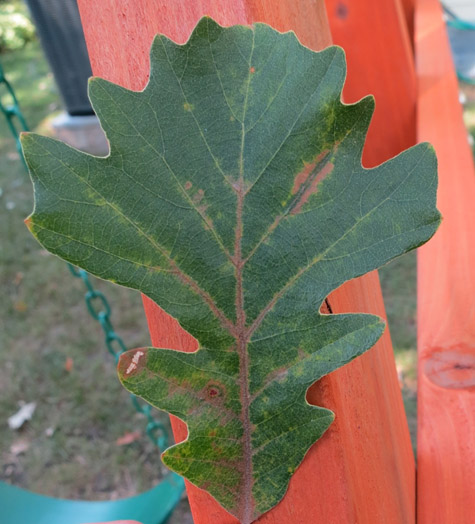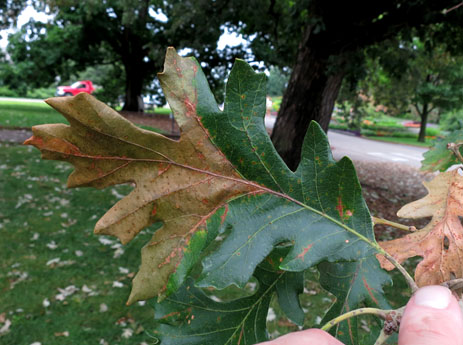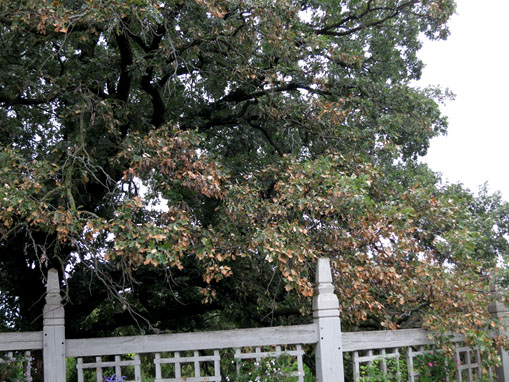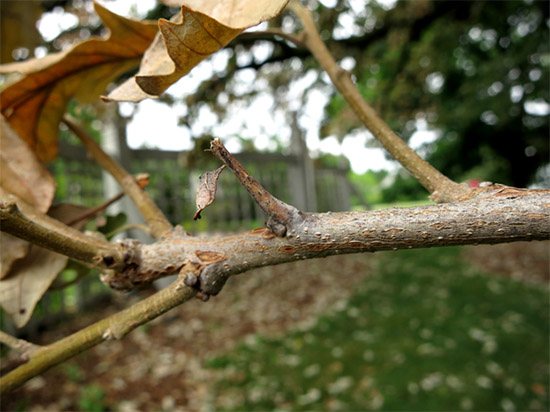Issue 15, September 11, 2017
Bur Oak Blight Moves South in Illinois
Bur Oak Blight (BOB) is a potentially serious fungal disease that only affects bur oak trees. After first being reported in Illinois in 2012, the Plant Clinic has received symptomatic samples almost every year. The pathogen was first identified in Iowa and appears to be present in almost every county in Iowa and Minnesota. For the first several years, the only confirmations in Illinois were in northern counties and one far western county (Hancock). Over the past few years we have received samples from central Illinois which were either confirmed or highly suspected of infection with the bur oak blight pathogen.
There are a couple of possible reasons for this apparent shift south: 1. The pathogen is becoming more prevalent in central Illinois and beginning to infect bur oak trees here, either due to pathogen movement or due to changing environmental conditions resulting in more favorable conditions for infection in the center of the state; 2. The public is more aware of what symptoms to look for when scouting bur oak trees, resulting in greater numbers of samples and confirmations at the Plant Clinic; 3. Some work has suggested that the variety oliviformis is more susceptible to this disease and it’s possible that the pathogen will move within this variety’s geographic range. Because identifying varieties can be difficult, the exact range of this variety is not known though it appears to be more common in northern Illinois.

This map indicates the counties in Illinois where bur oak blight has been identified. The counties in red were confirmed by Dr. Harrington, a professor at Iowa State University who first identified the causal agent of bur oak blight. The counties in green are counties where the pathogen has been confirmed by the University of Illinois Plant Clinic, while the counties in orange are ones from which we’ve received samples that we highly suspect are infected with bur oak blight, but we were unable to confirm the disease due to insufficient samples. McLean County was confirmed in 2016 while Menard and Peoria Counties were confirmed in 2017, and suspect samples from Champaign and Tazewell were also received this year.
Bur Oak Blight
Bur Oak Blight is a fungal leaf disease caused by the pathogen Tubakia iownesis. This is a relatively newly described pathogen, identified by Dr. Tom Harrington of Iowa State University. Several species of Tubakia are known to infect oak and cause minor leaf spots. Tubakia iowensis is the only species known to attack leaf petioles. Additionally, the pathogen will only infect Bur oak, particularly Quercus macrocarpa var. oliviformis. Results from his research suggest that the pathogen is native to the region and has only recently become problematic due to a significant environmental change. Moist springs, with significantly more precipitation, have likely created an environment favorable for disease development.
Symptoms
Bur oak blight is a late season leaf blight. The earliest symptoms of Bur Oak Blight first appear in June as purple-brown spots on the underside leaf veins. In July, the spots expand, and purplish necrotic veins become noticeable on the upper leaf surface (Image 1). The most notable symptoms appear in August and September as leaf veins are killed as the infection progresses and a characteristic wedge shaped necrotic area develops on the leaf blade (Image 2). Coalescing lesions and expanding vein necrosis may cause the leaf to die. Severely affected trees may have significant leaf mortality and/or leaves with scorched appearance (Image 3). Extensive premature defoliation is common, but many diseased leaves remain attached to the tree into the winter, well after healthy Bur oaks have dropped their leaves.
The retention of diseased leaves favors the pathogen and its spread. This pathogen over-winters as pustules on the still attached diseased leaf petioles. In late April and May, fungal spores are produced and released from the pustules about the same time as new leaves are developing and expanding. Heavy rainfall promotes spore production and disseminates this primary inoculum by splashing the spores to newly expanding leaves. Infection occurs before the leaves are fully developed. However, there is a latent period between infection and when the first symptoms appear in June.
Initially, infections may be limited to the lower braches. Symptoms intensify from year to year and progress from the lower branches to the entire crown.

Image 1. Purple-brown necrotic veins on the upper leaf surface associated with Bur Oak Blight

Image 2. Wedge-shape lesion characteristic of Bur Oak Blight

Image 3. Bur oak with lower canopy affected by Bur Oak Blight
Diseased leaf retention is currently one of the best ways to identify this disease in the field. Look for leaves and petioles attached from the previous growing season. Infected petioles will have black pustules or scars from previously attached pustules (Image 4). The other species of Tubakia that infect Bur oak are not known to produce these overwintering pustules.
Several successive years of severe infection and defoliation have been reported to kill trees. Death has also been attributed to secondary invaders such as the two-lined chestnut borer. Trees infected with BOB appear to have increased susceptibility to these secondary invaders.

Image 4. Branch with diseased petiole still attached from previous growing season. Note the small black pustules.
Management Strategies
- Fortunately, not all Bur oaks will be affected by this disease. Many Bur oak trees have a resistance to this pathogen. It’s not uncommon to observe a healthy unaffected Bur oak growing in close proximity to a severely infected tree.
- If you suspect a BOB infection, have the disease diagnosis confirmed by a laboratory. The leaf blight and scorching symptoms of BOB can be confused with other common disease such as: oak wilt, oak anthracnose, and environmental stresses. Disease confirmation is important for providing accurate disease control strategies and recommendations. Suspect BOB samples can be submitted to the University of Illinois Plant Clinic. Information on general sample submission can be found on the plant clinic website (http://web.extension.illinois.edu/plantclinic/). For Bur Oak Blight sampling, collect branches and twigs with symptomatic and healthy leaves. Be sure to include branches with petioles from previous growing season still attached (See Image 4 for example)
- Raking diseased leaves will have little effect on controlling the disease. The primary infection occurs from the abundant spores produced from diseased petioles that remain attached to the tree.
- Boosting tree vigor may help the tree to limit and prevent secondary invaders. Pruning and removing branch dieback has been suggested to help reduce borer populations
- For high value trees, Iowa State University found trunk injections of propiconazole to be effective at controlling the disease. Applications require specialized equipment and will need to be made by a certified professional.
- Injections should be made in late May or early June just after the leaves have fully expanded
- The recommended application rate is 8-10 mls per 1”DBH. Higher applications rates reportedly resulted in phytotoxicity to leaves. The rate will also need to be adjusted if the tree has significant branch dieback in the canopy.
- One application should last several years. Iowa State currently recommends repeat application only after a severe outbreak re-occurs.
References and Further Reading
US Forest Service Pest Alert: Bur Oak Blight (http://na.fs.fed.us/pubs/palerts/bur_oak_blight/bob_print.pdf)
Published Research Article-- Harrington T, McNew D, Hye Young Y. Bur oak blight, a new disease on Quercus macrocarpa caused by Tubakia iowensis sp. nov. Mycologia January 2012;104(1):79-92.
(Travis Cleveland & Diane Plewa)
Authors:
Travis Cleveland
Diane Plewa